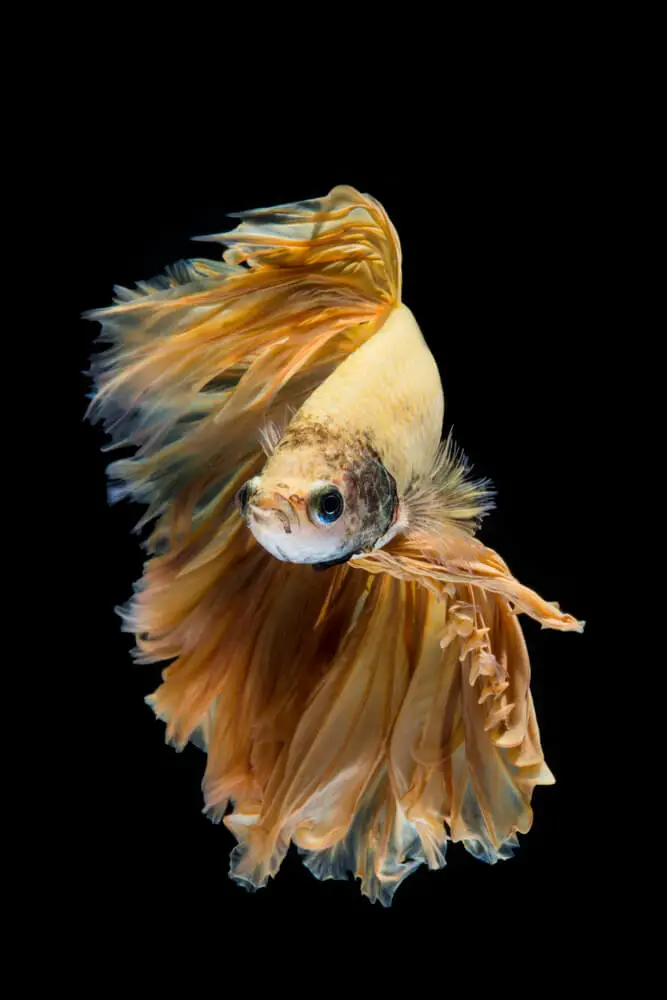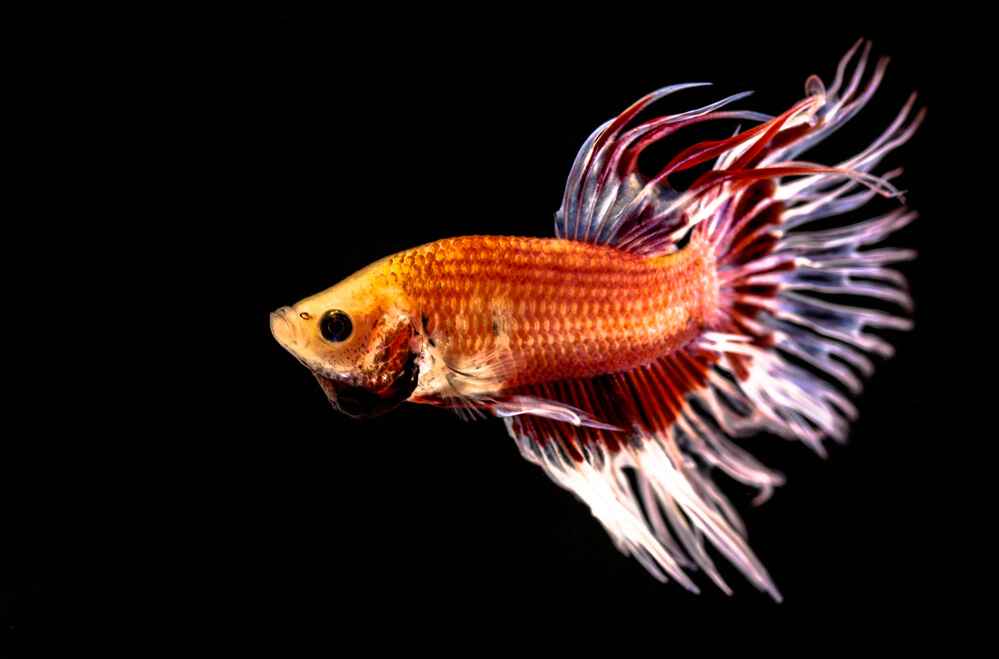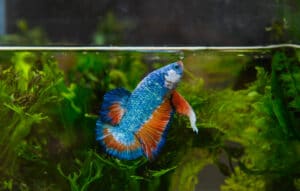If you’re a betta fish owner, you know how important it is to keep a close eye on your fish’s health and well-being.
One area that can be particularly concerning is the gills, as changes in color or appearance can be a sign of illness.
So if you’ve noticed that your betta’s gills are black, you may be wondering if this is normal or if it’s a cause for concern. Keep reading till the end to clear all doubts!
Is It Normal If Your Betta Fish Has Black Colored Gills?

The normal color of gills is red in most betta fish just like many other fish.
The gills of fish contain blood vessels which have a pigment called heme – responsible for the red coloration. Heme is a component of the protein hemoglobin. It is for the same reason our blood is also red.
If you happen to notice some black coloring in your betta’s gills, don’t panic! This is not uncommon and is not necessarily a cause for concern.
Betta fish have a membrane sometimes referred to as “beard.” They use it to flare out to make themselves look bigger and more intimidating. This membrane is located near the gills and you can see it completely when the betta fish is flaring.
So, if you see some black coloring in your betta’s gills, it’s likely just the beard and not an issue. That said, it’s also important to note that in some cases, black colored gills can also be a cause of concern.
Ammonia Burns – What Is It And How It Affects Betta Fish Gills?
Ammonia burn is a painful and serious condition that can affect betta fish when they are exposed to high levels of ammonia in their environment.
But what exactly is ammonia, and how does it harm these beautiful and popular aquatic pets?
Causes:
Ammonia is a chemical compound made up of nitrogen and hydrogen and it can be harmful to fish. It is produced when fish excrete waste or when organic matter decomposes in the water.
When the levels of ammonia in the water become too high, it can cause irritation and damage to the betta’s delicate gills and skin. Symptoms of ammonia burn include redness, and difficulty breathing. If left untreated, it can be fatal for the fish!
Treatment:
If you suspect that your betta is suffering from ammonia burn, it’s important to act quickly. The best course of action is to remove the fish from the contaminated water and place them in a separate tank or container with clean, treated water.
You can also use a water conditioner that specifically removes ammonia to help alleviate the symptoms.
But remember, water conditioners are usually designed to neutralize the ammonia and other unwanted chemical levels in the tank – only for a defined period. (For instance, water conditioners like Seachem Prime need to be re-dosed every 48 hours.)
After that you have to re-dose them to maintain the right water parameters and perform water changes.
It’s also important to maintain consistent water temperatures and avoid overfeeding, as these can contribute to the production of ammonia in the tank.
Prevention:
To prevent ammonia burn, it’s essential to regularly test the water quality in your betta’s tank and maintain proper levels of ammonia and other chemicals. This can be done through regular water changes and using a high-quality filter to remove impurities.
It’s also essential to avoid overcrowding the tank and properly dispose of any excess food or debris that may decompose and contribute to the buildup of ammonia. By following these simple steps, you can help keep your betta healthy and happy for years to come.
How To Know If It’s Beard Or Due To Ammonia Burns?
| Ammonia Burn | Black Membrane (Beard) |
| Redness or Purple Tinge In Gills | Dark Black Colored Near Gills |
| Betta Fish Struggling To Breathe | Betta Fish Is Healthy |
| More Mucus Production | Actively Swimming In The Tank |
| Inactivity And Appetite Loss | Black Membrane Displayed When Flaring |
One of the most obvious signs of ammonia burn is redness or a purple tinge in the gills. Sometimes, the dark color gills may also appear blackish. You may also observe increased mucus production and difficulty breathing in your betta fish.
In severe cases, your betta may become inactive and lose their appetite, struggling to swim around the tank.
On the other hand, if your betta is otherwise healthy and actively swimming around the tank, it’s less likely that their symptoms are due to ammonia burn. Instead, the black color in gills could be just as a part of normal coloration of the betta fish.
Why Do Betta Fish Flare?
Betta fish, also known as Siamese fighting fish, are known for their stunning iridescent fins.
But have you ever noticed your betta “flaring” its gills and spreading its fins wide open? This behavior, known as flaring, is actually a natural response to a perceived threat or challenge.
When a betta flares, it is trying to make itself look as large and intimidating as possible. This can be in response to another betta in close proximity or sometimes even to their reflection.
These fish are naturally territorial and will flare to establish dominance. They exhibit this flaring behavior to make themselves seem larger and more dangerous and to ward off any potential threats.
How To Keep Betta Fish Healthy And Happy?
Betta fish, also known as Siamese fighting fish, are beautiful and popular pets that can bring a touch of color and life to any home. However, like all pets, bettas require proper care and attention to keep them healthy and happy.
Here are seven tips to help you ensure the well-being of your aquatic friend:
- Provide a suitable home: Bettas need a spacious tank with good filtration and proper lighting. A tank that is at least 3 – 5 gallons is recommended for a single betta, but larger is always better. Be sure to also provide plenty of hiding spots and decorations to keep your fish entertained.
- Keep the water clean: Regular water changes and proper filtration are essential for maintaining a healthy environment for your betta. Water that is too dirty or has high levels of ammonia can lead to illness and stress.
- Feed a balanced diet: Bettas are omnivores and need a varied diet to stay healthy. Offer a mix of high-quality betta pellets, freeze-dried or frozen foods, and live or fresh foods. Avoid overfeeding, as excess food can lead to poor water quality and harm your fish.
- Maintain proper water temperature: Bettas are tropical fish and thrive in water that is between 75-80° Fahrenheit. Use a reliable heater to keep the water at a consistent temperature, and avoid placing the tank in direct sunlight or near windows.
- Be mindful of tank mates: While some bettas can coexist peacefully with other fish, it’s important to do your research and choose compatible tank mates. Avoid keeping bettas with aggressive or much larger fish, and be sure to provide enough space and hiding spots for all occupants.
- Handle your fish gently: Bettas are delicate creatures and can become stressed or injured if handled roughly. Use a soft net to transfer your betta from the tank to a container for cleaning or treatment.
- Provide mental stimulation: Bettas are intelligent and curious animals that need mental stimulation to stay happy and healthy. Offer a variety of toys, and other interactive items to keep your fish entertained and engaged.
By following these tips, you can help ensure that your betta fish has a long and happy life in your care.
Wrapping Up
In short, if your betta fish is healthy and active, the black gill could be the normal black colored membrane often called a beard – used by the fish while flaring. However, if your betta fish looks lethargic, struggles to breathe and has red gills – it could be due to ammonia burns (ammonia poisoning).
Regular water changes, proper feeding and nutrition, and a clean and suitable environment can all help keep your betta healthy and happy.
Need More Help In The Betta Keeping? Check out the following recommended guides:
- How Old Are Betta Fish At Pet Stores?
- Do Bettas Need Air Pump? (A Complete Guide!)
- Top 11 Reasons Betta’s Fins Look Shredded (+Treatment!)
Hi! I’m Praveen Ghoshal, the founder of eFishkeeping.com. Inspired by my Dad, I got interested in fishkeeping when I was a kid. Since then, I have been involved with this hobby. Currently, I have 3 fish tanks at our home, and I enjoy this hobby with my full family. Read more about me here.







